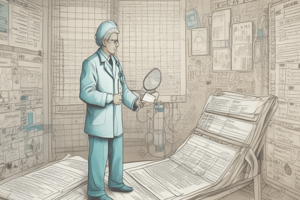Podcast
Questions and Answers
What should be documented when receiving a telephone report?
What should be documented when receiving a telephone report?
- The caller's phone number
- The date and time of the call (correct)
- The method of communication used
- The caller's credentials
Which of the following is crucial when giving a telephone report?
Which of the following is crucial when giving a telephone report?
- Detailing other clients' conditions
- Providing unverified information
- Stating the client's medical diagnosis (correct)
- Being vague to protect privacy
What is the primary purpose of nursing rounds?
What is the primary purpose of nursing rounds?
- To evaluate nursing care received by clients (correct)
- To take breaks between shifts
- To delegate tasks to other nurses
- To monitor nurses' performance
During a care plan conference, who can be invited to provide input?
During a care plan conference, who can be invited to provide input?
What is a key advantage of nursing rounds?
What is a key advantage of nursing rounds?
What is the primary purpose of client records?
What is the primary purpose of client records?
Which of the following is a guideline for recording client information?
Which of the following is a guideline for recording client information?
What should be done if a mistake is made in the client record?
What should be done if a mistake is made in the client record?
What is the role of a change-of-shift report in healthcare?
What is the role of a change-of-shift report in healthcare?
Which of the following is NOT a recognized purpose of client records?
Which of the following is NOT a recognized purpose of client records?
Flashcards are hidden until you start studying
Study Notes
Documenting and Reporting
- Discussion: An informal oral consideration of a subject by two or more healthcare professionals to identify a problem or establish strategies to resolve it.
- Report: Oral, written, or computer-based communication intended to convey information to others.
- Record (Chart or Client Record): A formal, legal document that provides evidence of a client's care, written or computer-based.
- Recording, Charting, or Documenting: The process of making an entry on a client record.
Purposes of Client Records
- Communication
- Planning client care
- Auditing health agencies (quality)
- Research
- Education
- Legal documentation
- Health care analysis (agency planning)
General Guidelines for Recording
- Date and Time: Should be documented for every entry.
- Timing: The frequency of documenting should be consistent and aligned with agency policy.
- Legibility: Entries should be easy to read.
- Permanence: Use permanent ink that does not smudge or fade.
- Accepted Terminology: Use standard medical and nursing terminology.
- Correct Spelling: Spell all terms correctly.
- Signature: Include name and title for identification.
Accuracy
- Objectivity: Record facts and observations rather than opinions or interpretations.
- Correction of Mistakes: Draw a line through the mistake, write "mistaken entry" above or next to it, and initial or sign next to the correction (following agency policy).
- Completeness: Document on every line, never between lines; if a blank space appears, draw a line through it.
Sequence
- Documents information in the order it occurred, starting with the most recent event first.
Appropriateness
- Document only information relevant to the client's care.
Conciseness
- Use concise and clear language.
Legal Caution
- Carefully document everything, as it's a legal document that can be used as evidence in court.
Reporting
- Change-of-Shift Report: Given to all nurses on the next shift to provide continuity of care by providing a quick summary of client needs and details of care.
Guidelines for Receiving a Telephone Report
- Document date and time.
- Record the name of the person giving the information.
- Record the subject of the information received.
- Sign the notation.
- Repeat information to ensure accuracy.
Guidelines for Giving a Telephone Report
- Be concise and accurate.
- State name and relationship to client.
- State client's name, medical diagnosis, changes in nursing assessment, vital signs related to baseline, significant laboratory data, and related nursing interventions.
- Have chart ready to give any further information needed.
- Document the date, time, and content of the call.
Care Plan Conference
- A meeting of a group of nurses to discuss possible solutions to specific client problems.
- Other healthcare providers may be invited to offer their expertise.
Nursing Rounds
- Purpose: Two or more nurses visit selected clients at bedside to:
- Obtain information to help plan nursing care.
- Provide clients with an opportunity to discuss their care.
- Evaluate the nursing care the client has received.
- Advantages:
- Clients can participate in the discussion.
- Nurses can see the client and the equipment used.
- Considerations: Use terms clients can understand.
Studying That Suits You
Use AI to generate personalized quizzes and flashcards to suit your learning preferences.




